#Low Capacitance ESD Protection
Explore tagged Tumblr posts
Text
https://www.futureelectronics.com/p/electromechanical--circuit-protection--esd-protection/nup2105lt1g-onsemi-7467806
Bus ESD Protection Diode, ESD protections circuit, Electrostatic discharge protection
NUP2105L Series 350 W Dual Line CAN Bus Protector ESD Protection Diode - SOT-23
#Circuit Protection Devices#ESD Protection & Diode Arrays#NUP2105LT1G#Onsemi#Bus#ESD protections circuit#Electrostatic discharge protection#equipment#Diode Array devices#Low Capacitance ESD Protection#high-voltage ESD#ESD protection array#LED Printing
1 note
·
View note
Text
Nexperia debuts ESD diodes tailored for 48V automotive data networks
July 9, 2025 /SemiMedia/ — Nexperia has launched the industry’s first ESD protection diodes specifically developed for 48 V automotive data lines, addressing a long-standing gap in electrostatic protection for next-generation EV and HEV communication networks. The new AEC-Q101 qualified portfolio includes six ESD diodes supporting reverse working voltages (VRWM) of 54 V, 60 V, and 72 V. Designed…
#48V vehicle systems#AEC-Q101 qualified#automotive ESD protection#CAN-FD protection#electronic components news#Electronic components supplier#Electronic parts supplier#low capacitance diodes#Nexperia diodes
0 notes
Text
https://www.futureelectronics.com/p/electromechanical--circuit-protection--tvs-diodes/sm6t36cay-stmicroelectronics-8034866
Diode arrays, ESD protection array, Bi Directional Transient Voltage Suppressor
SM6T Series 600 W 36 V Bi Directional Transient Voltage Suppressor - DO-214AA
#Circuit Protection Devices#TVS Diodes#SM6T36CAY#STMicroelectronics#ESD protection array#Bi Directional Transient Voltage Suppressor#Electrostatic discharge protection#equipment#Diode circuit#Low Capacitance TVS Diode Array
1 note
·
View note
Text
Low Capacitance Diodes for ESD Protection Market Outlook & Forecast till 2033
The competitive analysis of the Low Capacitance Diodes for ESD Protection Market include a comprehensive analysis of market trends, competitor landscape, consumer behavior, and potential opportunities. It should cover key demographics, market size, growth projections, and risk factors. The report should also highlight the methodology used for data collection and analysis, presenting findings with visual aids such as charts and graphs. Additionally, recommendations and strategic insights for stakeholders to make informed decisions are crucial. The report should be concise, well-organized, and provide actionable information for businesses aiming to navigate the market effectively.
Key Function:
A Low Capacitance Diodes for ESD Protection market research report serves to assess market dynamics, identify opportunities, and mitigate risks for businesses. It analyzes consumer preferences, competitor strategies, and economic trends. The report facilitates informed decision-making by presenting data on market size, growth potential, and emerging patterns. It aids in product development, pricing strategies, and market positioning. Additionally, market research reports help businesses understand their target audience, enhance marketing efforts, and optimize resource allocation. By offering actionable insights, these reports empower organizations to stay competitive, adapt to changing market conditions, and foster sustainable growth in a dynamic business environment.
Key Dynamics:
Market research reports capture vital dynamics, including market trends, competitive analysis, and consumer behavior. They reveal market size, growth projections, and regional nuances. SWOT analysis examines internal strengths and weaknesses, along with external opportunities and threats. Consumer insights delve into preferences, impacting product development and marketing strategies. The competitive landscape unveils key players, strategies, and market shares. Regulatory factors and industry challenges are explored, aiding risk assessment. Timely and accurate information empowers businesses to adapt strategies, capitalize on opportunities, and navigate challenges, ensuring informed decision-making and sustained competitiveness in dynamic markets.
Receive the FREE Sample Report of Low Capacitance Diodes for ESD Protection Market Research Insights @ https://stringentdatalytics.com/sample-request/low-capacitance-diodes-for-esd-protection-market/8260/
Market Segmentations:
Global Low Capacitance Diodes for ESD Protection Market: By Company • Infineon Technologies AG • Littelfuse • Onsemi • STMicroelectronics • Toshiba Electronic Devices & Storage Corporation • Nexperia • Good-Ark Semiconductor • Texas Instruments • Vishay Intertechnology, Inc • Guangdong Shikues Micro Industrial Co., Ltd Global Low Capacitance Diodes for ESD Protection Market: By Type • 2-Channel Type • 3-Channel Type • 4-Channel Type • 6-Channel Type Global Low Capacitance Diodes for ESD Protection Market: By Application • RF Switch • Antenna • Monitor • Speaker • Other
Regional Analysis of Global Low Capacitance Diodes for ESD Protection Market
All the regional segmentation has been studied based on recent and future trends, and the market is forecasted throughout the prediction period. The countries covered in the regional analysis of the Global Low Capacitance Diodes for ESD Protection market report are U.S., Canada, and Mexico in North America, Germany, France, U.K., Russia, Italy, Spain, Turkey, Netherlands, Switzerland, Belgium, and Rest of Europe in Europe, Singapore, Malaysia, Australia, Thailand, Indonesia, Philippines, China, Japan, India, South Korea, Rest of Asia-Pacific (APAC) in the Asia-Pacific (APAC), Saudi Arabia, U.A.E, South Africa, Egypt, Israel, Rest of Middle East and Africa (MEA) as a part of Middle East and Africa (MEA), and Argentina, Brazil, and Rest of South America as part of South America.
Click to Purchase Low Capacitance Diodes for ESD Protection Market Research Report @ https://stringentdatalytics.com/purchase/low-capacitance-diodes-for-esd-protection-market/8260/
Reseason To Purchase:
Purchasing a market research report is essential for businesses seeking a competitive edge. It provides in-depth insights into market trends, consumer behavior, and competitor strategies. This knowledge empowers informed decision-making, mitigates risks, and identifies growth opportunities. Market reports streamline strategic planning, enhance product development, and optimize resource allocation. For businesses entering new markets, these reports offer critical data for successful market entry. Additionally, the comprehensive analysis instills investor confidence, ensures regulatory compliance, and saves time compared to independent research efforts. Ultimately, investing in market research reports is a strategic move that enhances efficiency, minimizes uncertainties, and fosters sustainable business growth.
About Stringent Datalytics
Stringent Datalytics offers both custom and syndicated market research reports. Custom market research reports are tailored to a specific client's needs and requirements. These reports provide unique insights into a particular industry or market segment and can help businesses make informed decisions about their strategies and operations.
Syndicated market research reports, on the other hand, are pre-existing reports that are available for purchase by multiple clients. These reports are often produced on a regular basis, such as annually or quarterly, and cover a broad range of industries and market segments. Syndicated reports provide clients with insights into industry trends, market sizes, and competitive landscapes. By offering both custom and syndicated reports, Stringent Datalytics can provide clients with a range of market research solutions that can be customized to their specific needs.
Reach US
Stringent Datalytics
+1 346 666 6655
Social Channels:
Linkedin | Facebook | Twitter | YouTube
0 notes
Text
https://www.futureelectronics.com/p/electromechanical--circuit-protection--tvs-diodes/usblc6-2sc6y-stmicroelectronics-1103009
Bidirectional ESD Protection, diode circuit, Low Capacitance TVS Diode Array
USBLC6 Series 2 Line 6 V Uni / Bi Directional ESD Protection - SOT-23-6
#Circuit Protection Devices#TVS Diodes#USBLC6-2SC6Y#STMicroelectronics#Transient Voltage Suppressor diode#High-voltage transients#circuit#Bidirectional ESD Protection#diode circuit#Low Capacitance Array#application#suppression diode
1 note
·
View note
Text
Leiditech Recommends a TVS Diode with Low Leakage Current (100uA), Low Voltage (3.3V), and 400W Power
Transient Voltage Suppression Diode, or TVS for short. When the two poles of a TVS are impacted by reverse transient high energy, it can switch from high impedance to low impedance in 10⁻¹² seconds, absorb surge power up to several kilowatts, and clamp the voltage between the two poles at a predetermined value. This effectively protects precision components in electronic circuits from damage caused by various surge pulses.
Electronic products require power efficiency and energy savings, so they often use low-voltage power supplies such as 3.3V, 2.5V, or 1.8V. Especially for battery-powered electronics, low voltage alone is insufficient — low leakage current is also required.
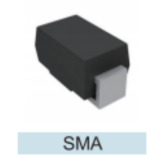

The advantage of low voltage drop and low leakage current is that the lower power loss ineffectively can improve the conversion efficiency of the power supply.
The advantages of low voltage drop and low leakage current include reduced power loss, which effectively improves power supply conversion efficiency.
The SMAJ3.3LIR can be widely used in automotive electronics, smart lighting, smart home systems, mobile phone fast-charging circuits, consumer electronics, switching power supplies, frequency converters, driver circuits, and other electronic circuits.
Leiditech’s SMAJ3.3LIR is already widely used in automotive electronics. Please contact us if you need it!
TVS Selection Tips
1. The TVS’s reverse working voltage (Vrwm) should be at least 10% higher than the maximum DC or continuous operating voltage of the protected circuit, as well as the circuit’s rated standard voltage and “high-side” tolerance. If the selected Vrwm is too low, the device may enter avalanche mode or disrupt normal circuit operation due to excessive reverse leakage current. Series connection divides voltage, while parallel connection divides current.
2. The TVS’s clamping voltage (Vc) should be lower than the damage threshold voltage of the protected circuit.
3. The TVS’s peak pulse power (Ppp) should exceed the peak pulse power that may occur in the protected circuit.
4. The TVS’s peak pulse current (Ipp) should be greater than the transient surge current in the circuit.
5. For lightning protection in data interface circuits, low-capacitance semiconductor ESD devices are recommended.
6. Select the TVS’s polarity and package based on the application: Bipolar TVS diodes are more suitable for AC circuits; semiconductor ESD arrays are more advantageous for multi-line protection
Leiditech is committed to becoming a leading brand in electromagnetic compatibility solutions and component supply, offering products such as ESD, TVS, TSS, GDT, MOV, MOSFET, Zener, and inductors. Leiditech has an experienced R&D team that can provide personalized customization services according to customer needs and offer the highest quality solutions.
If you’d like to learn more or have any questions, don’t hesitate to reach out:
Visit us at [en.leiditech.com]
#TVSdiode #CircuitProtection #ElectronicsDesign #Leiditech #SmartDevices #AutomotiveElectronics #3_3VProtection #LowLeakage #PowerEfficiency #SurgeProtection #ESDprotection #IoTdesign #EngineeringInnovation
0 notes
Text
Multi Purpose Diodes for ESD Protection Market: Share, Size, Trends, 2025–2032
Multi Purpose Diodes for ESD Protection Market, Global Outlook and Forecast 2025-2032
Multi Purpose Diodes for ESD Protection Market was valued at US$ 1.24 billion in 2024 and is projected to reach US$ 1.87 billion by 2032, at a CAGR of 5.43% during the forecast period 2025-2032
Our comprehensive Market report is ready with the latest trends, growth opportunities, and strategic analysis https://semiconductorinsight.com/download-sample-report/?product_id=88022
MARKET INSIGHTS
The global Multi Purpose Diodes for ESD Protection Market was valued at US$ 1.24 billion in 2024 and is projected to reach US$ 1.87 billion by 2032, at a CAGR of 5.43% during the forecast period 2025-2032.
Multi Purpose Diodes for ESD Protection are semiconductor devices designed to safeguard electronic circuits from electrostatic discharge (ESD) and transient voltage events. These diodes function as voltage clamps, diverting excess current away from sensitive components to prevent damage. The product range includes TVS diodes, switching diodes, rectifier diodes, and specialized variants catering to different voltage thresholds and response times. These components are critical for modern electronics where miniaturization increases ESD sensitivity.
The market growth is driven by increasing adoption in consumer electronics, automotive applications, and industrial automation systems. Rising demand for compact circuit protection solutions in 5G infrastructure and IoT devices further accelerates adoption. Key industry players like Infineon, Nexperia, and STMicroelectronics are expanding their portfolios with advanced low-capacitance diodes optimized for high-speed data lines. The U.S. accounts for approximately 28% of global demand, while China’s market is growing at 9.2% CAGR through 2031, fueled by local semiconductor manufacturing expansion.
List of Key Multi-Purpose Diodes for ESD Protection Companies
Infineon Technologies AG (Germany)
Nexperia BV (Netherlands)
SEMTECH Corporation (U.S.)
Vishay Intertechnology (U.S.)
Littelfuse, Inc. (U.S.)
BrightKing (China)
Amazing Microelectronic Corp (Taiwan)
STMicroelectronics (Switzerland)
ON Semiconductor (U.S.)
OmniVision Technologies (U.S.)
WAYON (China)
Prisemi (China)
Bourns, Inc. (U.S.)
LAN technology (China)
ANOVA (China)
MDE Semiconductor (U.S.)
TOSHIBA Electronic Devices (Japan)
UN Semiconductor (China)
PROTEK Devices (U.S.)
INPAQ Technology (China)
EIC Semiconductor (U.S.)
Segment Analysis:
By Type
TVS Diodes Segment Dominates the Market Due to High Demand for Robust ESD Protection
The market is segmented based on type into:
TVS Diodes
Subtypes: Uni-directional, Bi-directional, and others
Switching Diode
Rectifier Diode
Others
By Application
Automotive Segment Leads Due to Growing Adoption of Advanced Electronics in Vehicles
The market is segmented based on application into:
Automobile
Industrial
Power Supply
Military/Aerospace
Telecommunications
Others
Regional Analysis: Multi-Purpose Diodes for ESD Protection Market
North America The North American market for multi-purpose diodes for ESD protection is driven by high demand from the telecommunications, automotive, and aerospace sectors. With stringent safety and reliability standards, particularly in the U.S., industries prioritize high-performance ESD protection solutions. The rapid expansion of 5G infrastructure and electric vehicle (EV) adoption further fuels demand. Leading semiconductor manufacturers like Littelfuse and ON Semiconductor dominate the market, supported by technological innovation and regulatory compliance. However, supply chain disruptions and semiconductor shortages have recently impacted production timelines, increasing lead times for critical components.
Europe Europe’s market is shaped by strong industrial and automotive sectors, with Germany and the U.K. as key contributors. The European Union’s emphasis on environmental sustainability and advanced manufacturing drives adoption of diodes with low power consumption and high efficiency. Companies like Infineon and STMicroelectronics lead in innovation, particularly in automotive and IoT applications. However, the market faces challenges due to regulatory complexities and the need for RoHS-compliant components. The rise in renewable energy projects also creates opportunities for ESD protection diodes in power supply systems, boosting regional demand.
Asia-Pacific Asia-Pacific is the largest and fastest-growing market, led by China, Japan, and South Korea, owing to massive electronics manufacturing and industrial automation investments. The region benefits from cost-effective production capabilities and a robust semiconductor supply chain. TVS diodes are particularly in demand due to their widespread use in consumer electronics, including smartphones and wearables. However, competition is fierce, with local players like WAYON and BrightKing challenging global leaders. While affordability drives sales, quality concerns and intellectual property issues remain challenges for market expansion.
South America The market in South America is developing, with Brazil and Argentina as primary growth drivers. The increasing adoption of telecommunications infrastructure and industrial automation is boosting demand for ESD protection diodes. However, economic instability and limited local semiconductor manufacturing restrict market growth, making the region heavily reliant on imports. Despite these challenges, the renewable energy sector offers potential opportunities as governments invest in wind and solar power projects, requiring reliable power protection solutions.
Middle East & Africa This region exhibits gradual growth, supported by telecommunications expansion and increasing industrial investments in the UAE, Saudi Arabia, and South Africa. The demand for ESD protection diodes is rising in power supply and military/aerospace applications. However, the market remains constrained by limited local production, supply chain inefficiencies, and price sensitivity. Long-term growth potential exists if regional governments prioritize infrastructure development and regulatory frameworks to attract international semiconductor suppliers.
MARKET DYNAMICS
As telecommunications companies prepare for 6G deployment, the need for ESD protection capable of handling frequencies above 100GHz is creating significant opportunities. Early development cycles show that 6G components will require protection diodes with capacitance below 0.1pF while maintaining robust clamping performance. Several leading manufacturers have already announced development programs targeting these specifications, with prototype availability expected within the next two years. This technological evolution represents a potential market expansion worth $800M annually by 2028.
The AI revolution in semiconductor design is enabling more sophisticated ESD protection strategies. Machine learning algorithms are being used to optimize diode performance for specific application scenarios, creating opportunities for customized solutions. In automotive applications, intelligent ESD protection systems that adapt to changing environmental conditions are gaining traction, with adoption rates growing 40% year-over-year in advanced driver assistance systems. This trend is expected to accelerate as autonomous vehicle development progresses.
The semiconductor industry’s ongoing supply chain challenges are particularly acute for specialized components like multi-purpose diodes. Lead times for certain diode variants have extended beyond 52 weeks, forcing OEMs to redesign circuits or accept performance compromises. The situation is exacerbated by the concentration of specialty wafer production in limited geographic regions. While the industry is working to diversify manufacturing bases, establishing new capacity for specialized semiconductor processes remains a multi-year endeavor.
Modern electronic designs require ESD protection that doesn’t compromise signal integrity or power efficiency. Balancing these competing requirements has become increasingly difficult as data rates climb into the multi-gigabit range. A recent industry survey revealed that 68% of design engineers cite ESD protection integration as a significant challenge in high-speed interface design. This complexity is driving demand for application-specific diode arrays and integrated protection solutions, though these often carry higher price tags that impact project budgets.
The market is highly fragmented, with a mix of global and regional players competing for market share. To Learn More About the Global Trends Impacting the Future of Top 10 Companies https://semiconductorinsight.com/download-sample-report/?product_id=88022
FREQUENTLY ASKED QUESTIONS:
What is the current market size of Global Multi Purpose Diodes for ESD Protection Market?
Which key companies operate in this market?
What are the key growth drivers?
Which region dominates the market?
What are the emerging trends?
Related Reports:
https://semiconductorblogs21.blogspot.com/2025/07/global-market-for-gas-scrubbers-for.htmlhttps://semiconductorblogs21.blogspot.com/2025/07/transistor-outline-to-package-market.htmlhttps://semiconductorblogs21.blogspot.com/2025/07/force-sensing-capacitor-market-size.htmlhttps://semiconductorblogs21.blogspot.com/2025/07/video-adapter-market-opportunities.htmlhttps://semiconductorblogs21.blogspot.com/2025/07/storage-adapters-market-segmentation.htmlhttps://semiconductorblogs21.blogspot.com/2025/07/emi-suppression-filters-market.htmlhttps://semiconductorblogs21.blogspot.com/2025/07/cpu-embedded-wireless-lan-market-demand_8.html
CONTACT US: City vista, 203A, Fountain Road, Ashoka Nagar, Kharadi, Pune, Maharashtra 411014 [+91 8087992013] [email protected]
0 notes
Text
USB ESD protection, Electrostatic discharge protection, ESD protection array
RCLAMP Series 18 V 0.9 pF SMT RailClamp® Low Capacitance TVS Array - SOT-563
0 notes
Text
Robots' Eye: Guide to Electrostatic Surge Protection for Multispectral Sensors
1. Overview of Multispectral Sensors
Multispectral sensors split light into narrow wavelength bands using spectroscopic technology, convert the light into electrical signals via detectors, process the signals to extract multispectral features of targets, and identify material properties through differences in reflection/radiation across different spectral bands. Composed of optical components (imaging and spectroscopic elements), control, and display parts (signal processing and image presentation), they feature multi-band detection, high spectral resolution, and non-contact measurement. They are applied in agriculture, environment, medical care, industry, remote sensing, security, and other fields.
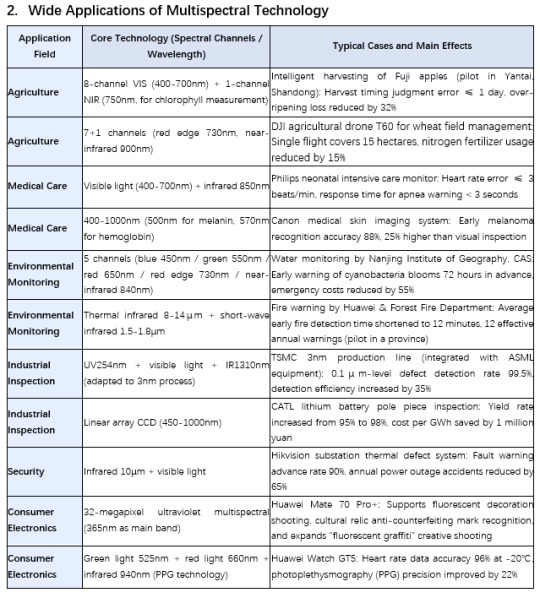
1. Leiditech’s Guidelines for Electrostatic Surge Protection of Multispectral Sensor Circuits
(1) Test and Certification Standards
l Surge immunity: According to IEC 61000–4–5, for 24V power input ports, line-to-line ±2kV, line-to-ground ±4kV, passing the 10/700μs waveform test.
l Electrostatic Discharge (ESD): Complying with IEC 61000–4–2, contact discharge ±8kV, air discharge ±15kV; medical equipment must reach contact ±6kV, air ±8kV, and pass YY 0505 certification.
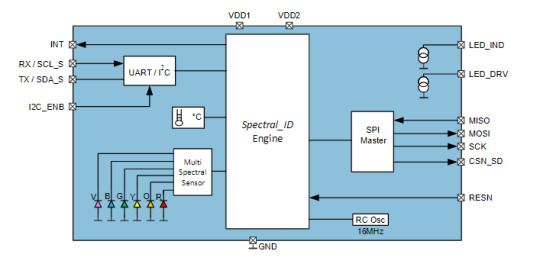
As shown in the figure above, the multispectral sensor chip interfaces mainly include power input port VCC, signal interfaces I2C/UART, and external interfaces (USB/Ethernet).
l Input Power Protection
24V industrial power supplies need to consider both surge and overcurrent protection:
o Surge protection: Recommended TVS device LM1K24CA (SMB package, VC=35V, low clamping voltage), with a protection level of 2kV;
o Overcurrent protection: SMD1812 series PTC (6–60V, 0.1–3.5A), with fast response speed and reusability;
o Reverse polarity protection: Schottky diode SK56C (60V/5A), reducing damage risk when the power supply is reversed.
o Alternatively, use the conventional scheme: front-stage GDT 2R090–5S + MOV, and rear-stage TVS for fine clamping.
l Signal Interface Protection
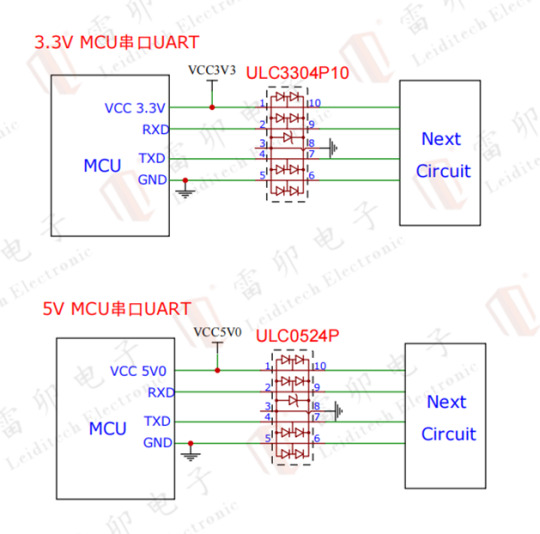
o For analog power (3.3V), Leiditech uses ESD0321CW (DFN0603 package, 30pF capacitance, 21A discharge current);
o For digital power (1.8V), Leiditech uses ESD1821C (DFN0603, 25pF, 18A) to reduce power ripple and electrostatic interference.
l Gigabit Network Lightning Surge Protection Scheme
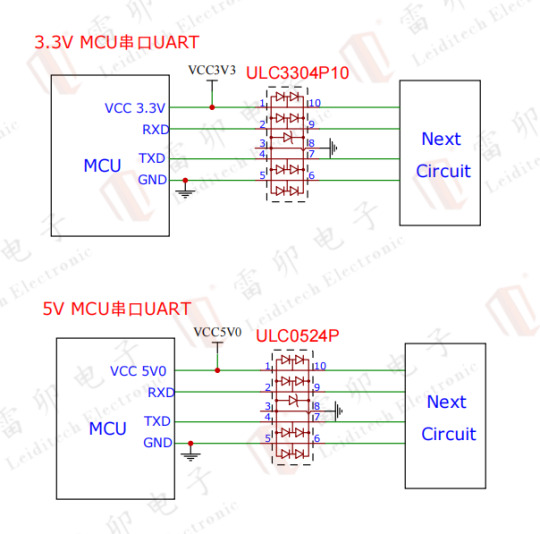
l Power Rail ESD Protection
o For analog power (3.3V), Leiditech uses ESD0321CW (DFN0603 package, 30pF capacitance, 21A discharge current);
o For digital power (1.8V), Leiditech uses ESD1821C (DFN0603, 25pF, 18A) to reduce power ripple and electrostatic interference.
l Gigabit Network Lightning Surge Protection Scheme
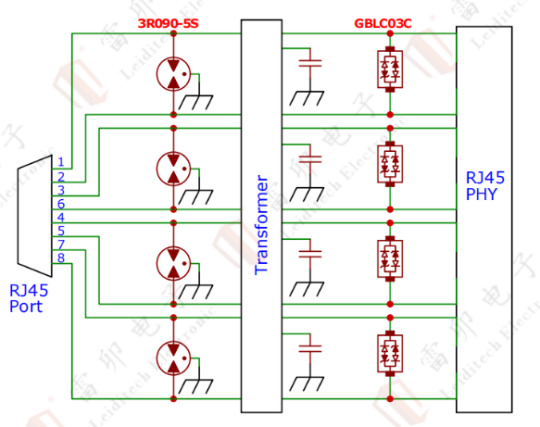
Leiditech Electronics is committed to becoming a leading brand in electromagnetic compatibility (EMC) solutions and component supply. We offer a wide range of products, including ESD, TVS, TSS, GDT, MOV, MOSFET, Zener diodes, and inductors. With an experienced R&D team, we provide personalized customization services to deliver the highest quality EMC solutions tailored to our customers’ needs.
#MultispectralSensors #SurgeProtection #ESDProtection #IndustrialTech #SmartAgriculture #MedicalDevices #Leiditech #ElectrostaticDischarge #TechInnovation #SensorTechnology #EMC #IoTDevices #EngineeringSolutions #PowerProtection #IndustrialAutomation #RemoteSensing
0 notes
Text
Types of ESD protection, what is ESD protection, Circuit protection solutions
RCLAMP Series 18 V 0.9 pF SMT RailClamp® Low Capacitance TVS Array - SOT-563
0 notes
Text
MOSFET's pull-down resistor serves what function?
MOSFET's pull-down resistor serves what function? (youtube.com)
What is the function of the pull-down resistor on the of a MOSFET?

The pull-down resistor between the gate (G) and source (S) of a MOSFET serves several functions:
1.Preventing False Turn-On: The Miller capacitance, a parasitic capacitor between the gate (G) and drain (D), can cause the MOSFET’s drain-source voltage (Vds) to change from nearly 0 (saturation voltage drop) to the bus voltage when the MOSFET is turned off. This rate of voltage change is "dv/dt." Since a capacitor responds to voltage changes by generating a current, the voltage change across the capacitor generates a current "i."
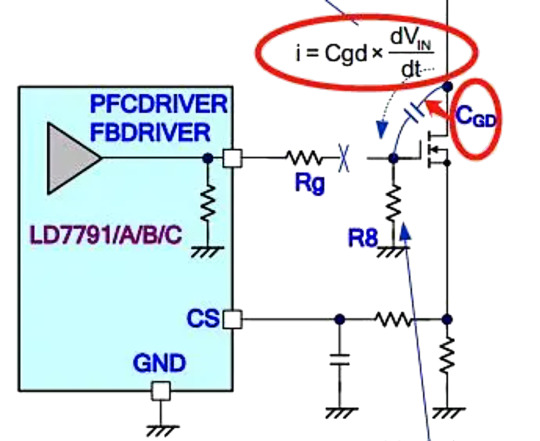
The gate-source (G-S) junction has an insulating layer, usually silicon dioxide (SiO2), making G-S a high-impedance path (tens to hundreds of megaohms). If there is a driving abnormality, the current through the Miller capacitance can charge the G-S junction. A small current through a high impedance can correspond to a high voltage, potentially charging the gate voltage above the threshold voltage "Vgs(th)," causing the MOSFET to turn on again, which is a dangerous situation.
2.Providing a Discharge Path: In a flyback power supply topology, the Miller capacitance current is discharged through a low-resistance path inside the driver chip, preventing the gate from being charged high enough to cause a false turn-on.
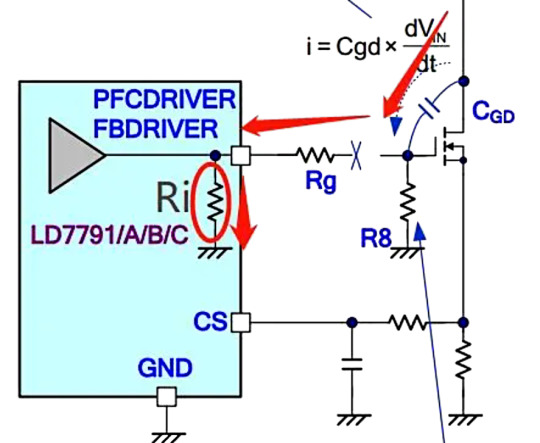
Here, we understand that there is already a discharge pull-down resistor inside the driver chip. However, if the gate resistor (Rg) is open-circuited or not connected for any reason, the external pull-down resistor (R8) can provide a discharge path for the Miller capacitance, keeping the G-S junction of the MOSFET at low impedance for a stable and safe state. This is a critical function of the pull-down resistor.


3.Pre-Protection Resistor: Another function of the pull-down resistor is as a pre-protection resistor. The G-S junction of a MOSFET is high-impedance, which is why it is sensitive to ESD. High voltage applied to the gate is not easily discharged and, over time, can damage the silicon dioxide layer between the G-S junction, leading to device failure.
Therefore, the pull-down resistor balances power consumption and effective discharge. Typically, for low to medium power supplies (0-500W), a resistor value of around 10K-20K is chosen, while for high-power supplies, 4.7K-10K is selected.
That concludes this content! Thank you for your support!
0 notes
Text
https://www.futureelectronics.com/p/electromechanical--circuit-protection--esd-protection/srda05-4-tbt-semtech-1727932
Electrostatic discharge protection, ESD protection diode, ESD protection circuit
SRDA Series 20 V 8 pF SMT RailClamp® Low Capacitance TVS Diode Array - SOIC-8
#Semtech#SRDA05-4.TBT#Circuit Protection Devices#ESD Protection & Diode Arrays#Electrostatic discharge protection#circuit#ESD protection equipment#ESD Tools#What is ESD protection#Zener diode#ESD protections#High Speed Data
1 note
·
View note
Text
A Brief Discussion on S-VIDEO Interface Electrostatic Surge Protection
The S-Video interface was once widely used in some older televisions, video recorders, game consoles, and other devices for transmitting video signals. However, with technological development, it has gradually been replaced by more advanced interfaces such as HDMI and DVI.
Today, the S-Video interface is still widely used in televisions, monitors, cameras, video recorders, and other video equipment. Compared with traditional composite video interfaces, it delivers better video quality, enabling clearer and more accurate images — making it particularly suitable for scenarios with high video display requirements.
Electrostatic surges can occur in the S-Video interface due to various factors, such as human touch, hot plugging, and weather conditions. If the interface is not equipped with ESD/EOS protection, it may cause damage to the internal video output chip, resulting in device malfunction.
Leiditech’s EMC expert team is specialized in electrostatic surge protection for electronic devices, with ten years of practical experience in serving customers. Shanghai Leiditech has launched electrostatic surge protection solutions for video interfaces including S-VIDEO.
Understanding the S-Video Interface
The S-Video interface (also known as the Y/C interface) is a video transmission standard. It splits video signals into two independent components: brightness (Y) and chromaticity ©, and transmits them separately. This separation avoids interference between brightness and chromaticity signals, improving video transmission quality with higher clarity and color accuracy.
S-Video interfaces typically come with 4-pin, 7-pin, or 9-pin connectors. The 4-pin connector is used to transmit basic brightness and chromaticity signals, while 7-pin or 9-pin connectors support additional functions such as audio transmission. This article takes the 4-pin connector as an example to introduce electrostatic surge protection schemes.
Protection Schemes
Scheme 1: Discrete Component GBLC05C
This scheme uses the ESD diode GBLC05C for electrostatic surge protection of the interface.
Advantages:
o Discrete components with SOD-323 packaging, facilitating wiring;
o Low capacitance;
o High IPP current (18A), ensuring signal transmission integrity while withstanding certain surges;
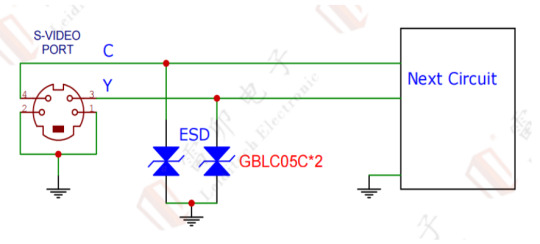
Scheme 2: Integrated Component LCC05DT3
This scheme uses the ESD diode LCC05DT3 for electrostatic surge protection of the interface.
Advantages:
o Integrated components with SOT-23 packaging, saving space;
o Low capacitance;
o High IPP current (12A), ensuring signal transmission integrity while withstanding certain surges;
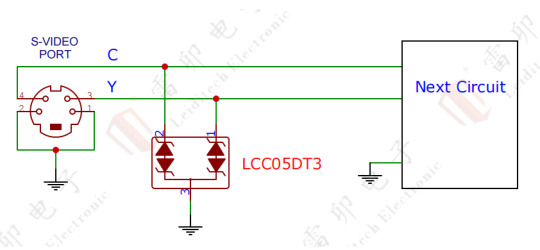
If you’d like to learn more or have any questions, don’t hesitate to reach out:
Visit us at [en.leiditech.com]
0 notes
Text
0 notes